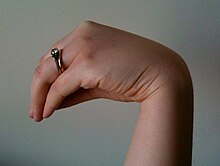Trousseau sign of latent tetany: Difference between revisions
m Bot: Migrating 7 interwiki links, now provided by Wikidata on d:q1458077 |
Tags: nowiki added Visual edit |
||
| Line 3: | Line 3: | ||
Trousseau sign of latent tetany is a [[medical sign]] observed in patients with low [[calcium]].<ref>Kumar, Abbas, Fausto. ''Pathologic Basis of Disease, 7th edition.'' Philadelphia: Elsevier-Saunders, 2005. 1188.</ref> This sign may become positive before other gross manifestations of [[hypocalcemia]] such as [[hyperreflexia]] and [[tetany]], as such it is generally believed to be more sensitive (94%) than the [[Chvostek sign]] (29%) for hypocalcemia.<ref>Fonseca OA, Calverly JR. Neurologic manifestations of hypoparathyroidism. Arch Intern Med 1967;120:202.</ref><ref>Schaat M, Payne CA. Effect of diphenylhydantoin and phenobarbital on latent tetany</ref> |
Trousseau sign of latent tetany is a [[medical sign]] observed in patients with low [[calcium]].<ref>Kumar, Abbas, Fausto. ''Pathologic Basis of Disease, 7th edition.'' Philadelphia: Elsevier-Saunders, 2005. 1188.</ref> This sign may become positive before other gross manifestations of [[hypocalcemia]] such as [[hyperreflexia]] and [[tetany]], as such it is generally believed to be more sensitive (94%) than the [[Chvostek sign]] (29%) for hypocalcemia.<ref>Fonseca OA, Calverly JR. Neurologic manifestations of hypoparathyroidism. Arch Intern Med 1967;120:202.</ref><ref>Schaat M, Payne CA. Effect of diphenylhydantoin and phenobarbital on latent tetany</ref> |
||
To elicit the sign, a [[blood pressure cuff]] is placed around the arm and inflated to a pressure greater than the [[systolic blood pressure]] |
To elicit the sign, a [[blood pressure cuff]] is placed around the arm and inflated to a pressure greater than the [[systolic blood pressure|systolic blood pressur]]<nowiki/>e. This will occlude the [[brachial artery]]. In the absence of blood flow, the patient's hypocalcemia and subsequent neuromuscular irritability will induce spasm of the muscles of the hand and forearm. The wrist and [[metacarpophalangeal joint]]s flex, the [[distal interphalangeal joint|DIP]] and [[proximal interphalangeal joint|PIP]] joints extend, and the fingers [[adduction|adduct]]. The sign is also known as '''''main d'accoucheur''''' ([[French language|French]] for "''hand of the [[obstetrician]]''") because it supposedly resembles the position of an obstetrician's hand in delivering a baby. |
||
The sign is named after French physician [[Armand Trousseau]] who described the phenomenon in 1861.<ref>Trousseau a. ''Clinique médicale de l'Hôtel-Dieu de Paris.'' Paris, 1861. Volume 2: 112-114.</ref> It is distinct from the [[Trousseau sign of malignancy]]. |
The sign is named after French physician [[Armand Trousseau]] who described the phenomenon in 1861.<ref>Trousseau a. ''Clinique médicale de l'Hôtel-Dieu de Paris.'' Paris, 1861. Volume 2: 112-114.</ref> It is distinct from the [[Trousseau sign of malignancy]]. |
||
Revision as of 14:58, 6 September 2013

Trousseau sign of latent tetany is a medical sign observed in patients with low calcium.[1] This sign may become positive before other gross manifestations of hypocalcemia such as hyperreflexia and tetany, as such it is generally believed to be more sensitive (94%) than the Chvostek sign (29%) for hypocalcemia.[2][3]
To elicit the sign, a blood pressure cuff is placed around the arm and inflated to a pressure greater than the systolic blood pressure. This will occlude the brachial artery. In the absence of blood flow, the patient's hypocalcemia and subsequent neuromuscular irritability will induce spasm of the muscles of the hand and forearm. The wrist and metacarpophalangeal joints flex, the DIP and PIP joints extend, and the fingers adduct. The sign is also known as main d'accoucheur (French for "hand of the obstetrician") because it supposedly resembles the position of an obstetrician's hand in delivering a baby.
The sign is named after French physician Armand Trousseau who described the phenomenon in 1861.[4] It is distinct from the Trousseau sign of malignancy.
References
- ^ Kumar, Abbas, Fausto. Pathologic Basis of Disease, 7th edition. Philadelphia: Elsevier-Saunders, 2005. 1188.
- ^ Fonseca OA, Calverly JR. Neurologic manifestations of hypoparathyroidism. Arch Intern Med 1967;120:202.
- ^ Schaat M, Payne CA. Effect of diphenylhydantoin and phenobarbital on latent tetany
- ^ Trousseau a. Clinique médicale de l'Hôtel-Dieu de Paris. Paris, 1861. Volume 2: 112-114.
Template:Eponymous medical signs for endocrinology
